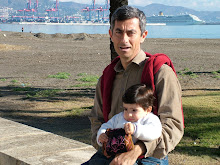The type and length of an eclipse depend upon the Moon’s location relative to its orbital nodes. The next total lunar eclipse occurs on December 21, 2010. Unlike a solar eclipse, which can only be viewed from a certain relatively small area of the world, a lunar eclipse may be viewed from anywhere on the night side of the Earth. A lunar eclipse lasts for a few hours, whereas a total solar eclipse lasts for only a few minutes at any given place.
The Moon orbits Earth about once every 29 and a half days. As it circles our planet, the changing position of the Moon with respect to the Sun causes our natural satellite to cycle through a series of phases: New Moon > New Crescent > First Quarter > Waxing Gibbous> Full Moon > Waning Gibbous > Last Quarter > Old Crescent > New Moon (again).
The phase known as New Moon can not actually be seen because the illuminated side of the Moon is then pointed away from Earth. The rest of the phases are familiar to all of us as the Moon cycles through them month after month.
When the Moon is Full, it rises at sunset and is visible all night long. At the end of the night, the Full Moon sets just as the Sun rises. None of the Moon's other phases have this unique characteristic. It happens because the Moon is directly opposite the Sun in the sky when the Moon is Full. Full Moon also has special significance with regard to eclipses.
Types of Lunar Eclipses
1. Penumbral Lunar Eclipse. The Moon passes through Earth's penumbral shadow. These events are of only academic interest because they are subtle and hard to observe.
2. Partial Lunar Eclipse. A portion of the Moon passes through Earth's umbral shadow. These events are easy to see, even with the unaided eye.
3. Total Lunar Eclipse. The entire Moon passes through Earth's umbral shadow. These events are quite striking due to the Moon's vibrant red color during the total phase (totality).
Now you might be wondering "If the Moon orbits Earth every 29.5 days and lunar eclipses only occur at Full Moon, then why don't we have an eclipse once a month during Full Moon?". I'm glad you asked! You see, the Moon's orbit around Earth is actually tipped about 5 degrees to Earth's orbit around the Sun. The Moon spends most of the time either above or below the plane of Earth's orbit.
When an eclipse of the Moon takes place, everyone on the night side of Earth can see it.
Why is the Moon Red During a Total Lunar Eclipse?

During a total lunar eclipse, the Earth blocks the Sun's light from reaching the Moon.
While the Moon remains completely within Earth's umbral shadow, indirect sunlight still manages to reach and illuminate it. However, this sunlight must first pass deep through the Earth's atmosphere which filters out most of the blue colored light.
The remaining light is a deep red or orange in color and is much dimmer than pure white sunlight.
Enjoy this video about Moon's eclipses!
Click here to read a transcription.
Try to guess the missing words and send me your answers!
===========================================
Exercises about Lunar and Solar eclipses



1-shadow
ResponderEliminar2-lunar
3-casts
4-full
5-moon
6-earth
7-darkness
8-ecliptic
9-seasons
10-sky
1-shado
ResponderEliminar2-lunar
3-cast
4-ful
5-moon
6-earth
7-darknes
8-ecliptic
9-sisons
10-sky
Parece ser que ya está solucionado el problema de los comentarios. Andy y John ya han enviado sus respuestas.
ResponderEliminarSaludos
¿Tú dices que habla bien?
ResponderEliminarpues será para ti,porque según ella "la tierra "cas" una sombra. se puede saber que es "cas" o "moonrar"."Cas" no será "cast" por que almenos con cast tiene un poco mas de sentido.
1-shadow
ResponderEliminar2-moon
3-cast
4-full
5-moon
6-Earth
7-darks
8-ecliptic
9-seasons
10-sky
Pues sí José Antonio, habla clarísimo y no muy rápido, quizá no la entiendas porque habla en inglés... De todas maneras no me parece apropiado el tono de tu comentario. Gracias por participar, el lunes mostraré todas las respuestas.
ResponderEliminar1-SHADOW
ResponderEliminar2-MOON´S
3-CAST
4-FULL MOON
5-?????
6-EARTH
7-DARK
8-????
9-EVEN
10-HIGH
cuales son las fases de la luna en espanol
ResponderEliminar